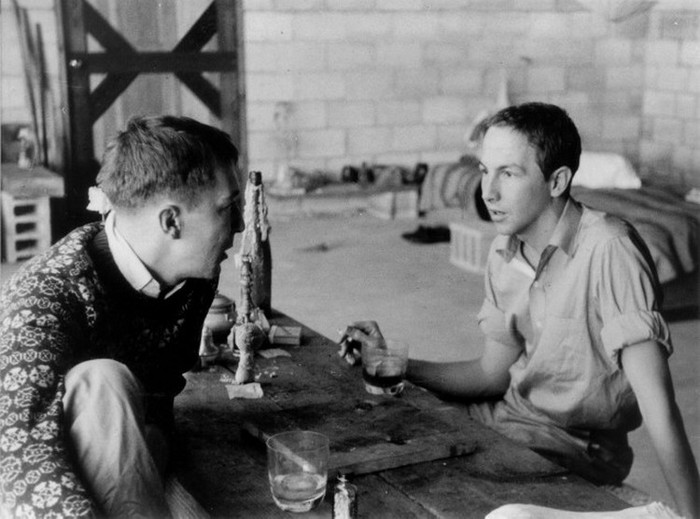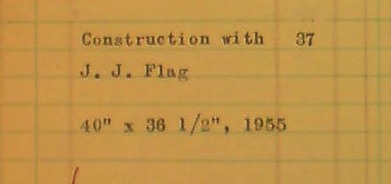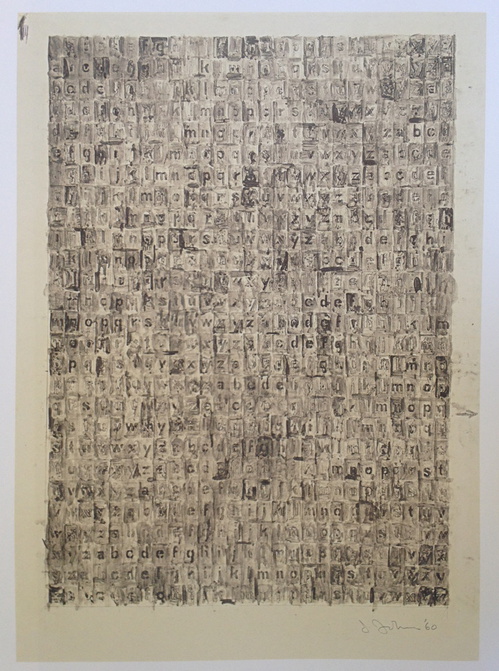
Short Circuit (aka Construction with J.J. Flag), c. 1958? photo: Rudy Burckhardt
Errol Morris’s new film about Donald Rumsfeld has me thinking a lot lately in terms of the known unknown, and the unknown unknown. As I’ve tried to find the missing Jasper Johns flag painting that was in Robert Rauschenberg’s 1955 combine Short Circuit I’ve kept running into another formulation which bridges the two: what we think we know.
It’s not that the story of Short Circuit as it trickled down through history in footnotes and parentheticals and anecdotes was wrong, so much as incomplete. . And the elisions have shaped the widely accepted understanding of both artists’ work. But it also prompts the question, “Who’s ‘we’?”
Because someone knows what happened to that flag painting. Someone’s always known. It just wasn’t me.
My first questions about a missing Johns flag arose only after the second time I’d seen Short Circuit, at Gagosian’s Rauschenberg show in 2010. Calvin Tomkins told Leo Castelli’s story about a dealer bringing the flag to be authenticated, only to be told it had been stolen. “The dealer refused to part with it. He took the little painting away, and nobody has seen it since.” To which I wrote, “Nice, but not true. At least two people have seen it since: the dealer, and the perp. If they fenced it elsewhere, you can add a third or more. You stay classy, art world!”
I called Ivan Karp, who had already been providing bemused advice for my search for the lost/fictitious Pop painter Vern Blosum, who told me in confidence the name of the dealer and the person he was representing. The dealer had passed away many years ago; his client was still around. I’ve spoken with this Person several times over the last 3.5 years, but I’ve never felt comfortable naming either of them.
In the course of multiple phone conversations, I grew confident of their knowledge of and association with the flag painting. That it had passed through their hands. I tested facts and dates as I found them out through various archive dives and interviews, and I’d usually, eventually, get a hypothetical yes, or at least a non-denial of an assertion-as-a-question. For example, the flag was removed while Rauschenberg’s painting was in Castelli’s warehouse. The gallery filed a police report on June 8th, 1965, but reported the theft as occurring on April 15th. Artist/photographer Ed Meneeley told of a frantic inquiry that spring and summer, trying to find the painting. The Person recalled a similar situation happening, or yes, hearing about it.
Leo had sent a cursory note to the Art Dealer’s Association which never made it into the Art Loss Register. There were a couple of notes about “JJ Insurance” in Leo’s calendar, but hardly any of the files or correspondence like those generated by other claims in that era. The Dealer’s name appears many times, before and after 1965; Leo knew him, and knew him well. But he was never mentioned regarding the painting. And in his tellings of the story, Leo was all discretion, always leaving the names out.
Except when he didn’t.
Last year, I stumbled across a second interview Leo Castelli made with Paul Cummings for the Archive of American Art’s Oral History Project. The first, conducted in 1969, had been there all along, but I never saw the second, conducted in 1973. [Transcripts of the two sessions are combined in the AAA’s online version. Hol Art Books has just made very nice e-book versions available for many of the AAA interviews, including Castelli’s.]
LEO CASTELLI: Well, that sort of brings back early, my early feelings about Bob. Well anyway so there were these things that went on down at the Stable. There was this famous episode where he smuggled a Jasper Johns painting in with his paintings at the Stable. Do you know about that thing?
PAUL CUMMINGS: No.
LEO CASTELLI: Oh, that was a fantastic story, those people who exhibited at the Annual. There was a group of painters, mostly the ones that were in the first Annual, who could then propose I think one other painter to join the group the next year. So Bob proposed Jasper and that must have been for the ’54 Annual, because Jasper didn’t do flags before then, even perhaps ’55, I don’t know how long those Annuals went on.
PAUL CUMMINGS: Quite a while but they changed after a while.
LEO CASTELLI: Anyway, ’54 it was, or ’55 it must have been, yes. Because he didn’t do flags that were as perfect before that. Maybe ’54, but ’55 is more likely. So he proposed Jasper Johns and well, there was a committee who went around to see if they approved. It was actually two persons because he proposed Jasper Johns and Sue Weil, his ex-wife, who now is married to Bernard Krusendof. And the committee rejected them both, they didn’t like what they were doing.
So then Robert did a large structure, which still exists, and he put into this structure a painting of Jasper’s, a flag and a painting of Sue Weil’s which was sort of a little dish and they were enclosed with little doors in front of them and they were closed. It was a typical Rauschenberg painting of the period, his collage and materials and things and everything and he brought it in and claimed it as his painting. Then when it was all hung and the show started he opened the door and here on the left hand side was Jasper Johns and on the right hand side was Sue Weil.
I think there is a coda to that story. I had very bad warehouses at the time, very sloppy kind of treatment, that was one that I had on First Avenue. And it was much too accessible through an elevator to anyone who wanted to go in there and people and paintings were stacked badly and it was generally a sloppy organization.
Well, one day Bob Elkon called me and said, I have a very pretty Flag of Jasper Johns, I don’t know whether it’s authentic or not, it’s not signed and I would like to show it to you. So he came with the Flag and there it was, the Flag that was the inside the painting! I sent somebody down to the warehouse and I told them to open that case and see if the painting of the Flag was there and it wasn’t there. So I said this is a stolen Flag so please leave it here. He said no, it’s been given to me by somebody who would suffer direly if I didn’t give it back to her (it’s Gertrude Stein by the way) and please let me take care of it, I’ll get it to you. I said alright if you promise that you’ll take care of it and get it back and straighten it out with her. I never got it right back. He made a terrible hysterical scene and said I must have the Flag back. She never did and the Flag disappeared for good.
PAUL CUMMINGS: And it has never turned up since?
LEO CASTELLI: Never turned up again.

Johns ampersand Rauschenberg in 1954.
OK, then. Cats’re out of that bag. And with so many questions trailing behind them, too. For one thing, what does this do to the sequence of events in the summer of 1965? Castelli has the Dealer’s visit as the tip-off to the flag’s disappearance. Was it also the trigger for the gallery’s frantic two-month search for his client? Which means the June police/insurance report not the genesis, but the denouement?
That would differ from the sequence Castelli told Michael Crichton, who included it in his utterly awesome catalogue for Johns’ 1977 Whitney retrospective. And of course “at the time” was 1965, a full decade after Short Circuit was made. Isn’t it interesting that Castelli, of all people, doesn’t call it a “combine” or even “combine painting,” but “a structure”? And in Rauschenberg’s earliest registry, from 1957-9, it was called a “construction.” Construction with J.J. Flag.

tiny detail of a Robert Rauschenberg registry, dated 1957-9, from the Castelli Gallery Papers at the AAA
Also, he “didn’t get it right back,” but yet he knew it “disappeared for good?”
And it gets better:
PAUL CUMMINGS: Well, one of the things that has always interested me as an outside observer you might say, is that Rauschenberg and Johns have been through all the changes and activities kind of more than just one of the artists in the stable.
LEO CASTELLI: Well, in more than one sense this is true. They were to begin with almost the gallery. There were three people that were the gallery; myself, Rauschenberg and Johns. As a matter of fact it was Rauschenberg hyphen Johns, because they seem to be sort of always mentioned in the same breath, Rauschenberg and Johns. As a matter of fact, later on Johns got (there were other reasons too) got so irked by this constant coupling that occurs that he–this is certainly one of the reasons why he broke with Rauschenberg.
PAUL CUMMINGS: Really?
LEO CASTELLI: Because he just did not want to be constantly mentioned in the same breath as Rauschenberg. Well there were other reasons of course, they started diverging also on aesthetic grounds and so on. Rauschenberg did not approve of the direction that Johns was taking and Johns didn’t approve of what Rauschenberg was doing, especially when the silkscreens came up. I think that was a moment that Johns rejected, that he didn’t like at all. And I think that when Jasper abandoned the emblematic image and became very personally mysterious in what he was doing, Rauschenberg didn’t like that too much either.
So there was a split that occurred in the early sixties and for a time really they didn’t see each other at all. I can even date it (how things come back!) because I was down at–I’m almost convinced because there are dates of paintings or drawings that can remind me of the exact dates–I was down at Lombot Key, that’s near Sarasota, Jasper had taken a little place, a little house there on the beach and he invited me to come down to spend a few days there and I noticed Rauschenberg was around in that area too, and that–really Jasper didn’t want to see him.
I was rather embarrassed because I was a good friend of both of them and not to be able to see Bob when he was around seemed to me a rather difficult position that I was in. But Jasper said that he did not want to see him. So that split must have occurred quite early, perhaps already in the beginning of 1960 or even late ’59.
Johns, Gray Alphabets, 1960, collection Jean-Christophe Castelli, is on loan to the Fogg Museum, and was in the Art Institute & the Met’s amazing Jasper Johns Gray show in 2008.
And I can remember it because down at Lombot Key he did a series of drawings of which I have one, an alphabet drawing which he was doing at the time when I was there and so that dates my recollection of the split very accurately.
Rauschenberg hyphen Johns. The emblematic image. Constant coupling. Short Circuit may be at the center of the original conscious uncoupling. Except that Rauschenberg only began using silkscreens in 1962. And Johns was writing to Castelli, informally scouting out Tokyo gallery spaces for Rauschenberg’s shows, in 1964. When you share a dealer, a tight group of friends, and several jointly produced artworks, including the first example of your most emblematic image, uncoupling can be complicated. Someone once told me dealers were not anxious to be involved in such problems as these, and I can understand why.
Anyway, when I found this 40-year-old interview last year, I called the Person one more time, telling them about it, and asking if they recalled maybe, since Castelli knew the Dealer and knew the Dealer knew, maybe she’d/they’d sold the painting back to Johns. At which point the Person hung up on me.
So I guess we’ll never know.

